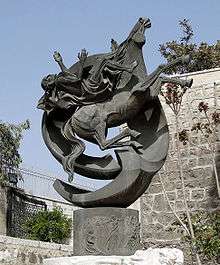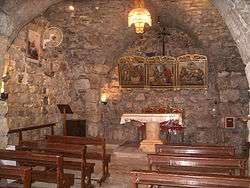Acts 9
| Acts 9 | |
|---|---|
|
Acts 15:22-24 in Latin (left column) and Greek (right column) in Codex Laudianus, written about AD 550. | |
| Book | Acts of the Apostles |
| Bible part | New Testament |
| Order in the Bible part | 5 |
| Category | Church history |
Acts 9 is the ninth chapter of the Acts of the Apostles in the New Testament of the Christian Bible. It records Saul's conversion and the works of Saint Peter.[1] The book containing this chapter is anonymous but early Christian tradition uniformly affirmed that Luke composed this book as well as the Gospel of Luke.[2]
Text
The original text is written in Koine Greek and is divided into 43 verses. Some most ancient manuscripts containing this chapter are:
- Papyrus 53 (3rd century; extant: verses 33 to chapter 10:1)
- Codex Vaticanus (AD 325-350)
- Codex Sinaiticus (AD 330-360)
- Codex Bezae (ca. AD 400)
- Codex Alexandrinus (ca. AD 400-440)
- Codex Ephraemi Rescriptus (ca. AD 450)
- Codex Laudianus (ca. AD 550)

Structure
This chapter can be grouped:
- Acts 9:1-9 = The Damascus Road: Conversion of Paul the Apostle
- Acts 9:10-19 = Ananias Baptizes Saul
- Acts 9:20-22 = Saul Preaches Christ
- Acts 9:23-25 = Saul Escapes Death
- Acts 9:26-30 = Saul at Jerusalem
- Acts 9:31 = The Church Prospers
- Acts 9:32-35 = Aeneas Healed
- Acts 9:36-43 = Dorcas Restored to Life
Cross references
Verse 5
- And he said, “Who are You, Lord?”
Verse 17

- And Ananias went his way and entered the house; and laying his hands on him he said, “Brother Saul, the Lord Jesus, who appeared to you on the road as you came, has sent me that you may receive your sight and be filled with the Holy Spirit.”[4]
Verse 19
- So when he had received food, he was strengthened. Then Saul spent some days with the disciples at Damascus.
John Gill suggested in his Exposition of the Bible that these disciples were among those dispersed from Jerusalem to Judea and Samaria at the onset of the Christian persecution described in Acts 8:1 [5]
Verse 25

- Then the disciples took him by night and let him down through the wall in a large basket.[6]
Saul was helped to escape the city in a similar manner to how Rahab helped two spies to escape prior to the Battle of Jericho (Joshua 2:15), and Michal, the daughter of King Saul helped her husband, David (1 Samuel 19:12).[7]
Conversion of Paul the Apostle
According to the New Testament, this event took place in the life of Paul the Apostle which led him to cease persecuting early Christians and to become a follower of Jesus. It is normally dated by researchers to AD 33–36.[8][9][10] The phrases Pauline conversion, Damascene conversion and Damascus Christophany, and road to Damascus allude to this event. Within the New Testament, Paul's conversion experience is discussed in both Paul's own letters and in the book known by the title Acts of the Apostles. According to both sources, Paul was never a follower of Jesus and did not know Jesus before his crucifixion. Instead, he severely persecuted the early Christians. Although Paul refers to himself as an "Apostle" of Jesus, it is clear that Paul was not one of "The Twelve" apostles.[1 Cor. 9:1-2] Paul's conversion occurred after Jesus' crucifixion. The accounts of Paul's conversion experience describe it as miraculous, supernatural, or otherwise revelatory in nature.
See also
References
- ↑ Halley, Henry H. Halley's Bible Handbook: an abbreviated Bible commentary. 23rd edition. Zondervan Publishing House. 1962.
- ↑ Holman Illustrated Bible Handbook. Holman Bible Publishers, Nashville, Tennessee. 2012.
- ↑ Acts 9:5
- ↑ Acts 9:17
- ↑ Gill's Exposition of the Bible http://biblehub.com/commentaries/gill/acts/9.htm, accessed 24 August 2015
- ↑ Acts 9:25
- ↑ The Nelson Study Bible. Thomas Nelson, Inc. 1997
- ↑ Bromiley, Geoffrey William (1979). International Standard Bible Encyclopedia: A-D (International Standard Bible Encyclopedia (W.B.Eerdmans)). Wm. B. Eerdmans Publishing Company. p. 689. ISBN 0-8028-3781-6.
- ↑ Barnett, Paul (2002). Jesus, the Rise of Early Christianity: A History of New Testament Times. InterVarsity Press. p. 21. ISBN 0-8308-2699-8.
- ↑ L. Niswonger, Richard (1993). New Testament History. Zondervan Publishing Company. p. 200. ISBN 0-310-31201-9.
